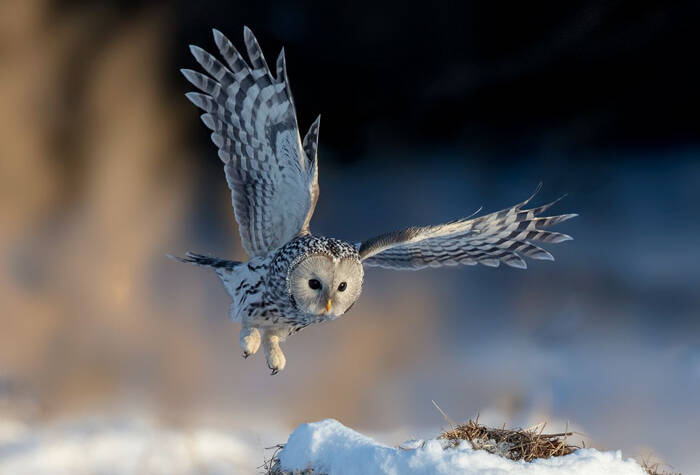Strix uralensis
IUCN
LCBasic Information
Scientific classification
- name:Strix uralensis
- Scientific Name:Strix uralensis,Brown Wood-owl
- Outline:Raptor
- Family:Strigiformes Owl
Vital signs
- length:45-53cm
- Weight:452-842g
- lifetime:About 10-20 years
Feature
The tail feathers are longer, slightly rounded, with prominent horizontal spots and white end spots.
Distribution and Habitat
Distributed in Albania, Austria, Belarus, Bosnia and Herzegovina, Bulgaria, China, Croatia, Czech Republic, Estonia, Finland, Germany, Hungary, Italy, Japan, Kazakhstan, South Korea, North Korea, Latvia, Lithuania, Macedonia, Mongolia, Montenegro, Norway, Poland, Romania, Russian Federation, Serbia, Slovakia, Slovenia, Spain, Sweden, Ukraine.
In China, it is distributed in Heilongjiang, northeastern Inner Mongolia, Beijing, Liaoning, Jilin, Henan, Sichuan, Qinghai and Xinjiang. Rare resident bird. The northern subspecies is distributed in the Greater Khingan Mountains and Lesser Khingan Mountains in Northeast China; the northeastern subspecies is distributed in the Changbai Mountain area of Jilin and Liaoning, and is also distributed in Hebei.
The long-tailed forest owl inhabits mountain coniferous forests, mixed coniferous and broad-leaved forests and broad-leaved forests, especially broad-leaved forests and mixed coniferous and broad-leaved forests. It occasionally appears in
Appearance
The head is round, without ear tufts, and the face plate is prominent, gray-white, with fine dark brown feather trunk lines. The ruffled collar is also prominent. The body feathers are mostly light gray or gray-brown, with dark brown stripes. The stripes on the lower body are particularly extended, and there are only vertical stripes and no horizontal spots. The tail feathers are longer, slightly rounded, with significant horizontal spots and white end spots. The iris is dark brown, the mouth is yellow, and the claw horns are brown.
Size measurements: body weight ♂452-551g, ♀502-842g; body length ♂488-532mm, ♀450-538mm; bill peak ♂33-36mm, ♀34-42mm; wings ♂313-347mm , ♀310-348 mm; tail ♂249-273 mm, ♀225-279 mm; tarsometatarsus ♂55-68 mm, ♀46-73 mm. (Note: ♂ male; ♀ female)
Details
Brown Wood-owl, also known as Brown Wood-owl, is a medium-to-large nocturnal bird of prey with 11 subspecies.

Brown Wood-owl is usually active alone except in pairs during the breeding season. During the day, they mostly live in the deep forest, standing upright on thick horizontal branches close to the tree trunks. Since their body color is very similar to that of the trees, they are difficult to be found even though they are not very hidden. Sometimes they are active and hunt during the day. In the cold winter, they often hide in tree holes to avoid the wind and snow, and sometimes they even knock on the tree trunks without flying out. They are mostly active in the middle and lower layers of the forest, and only fly over the tree canopy when they are flying long distances. When chasing squirrels, they rise and fall with the squirrels, often making a "whoosh" threatening sound while flying. When flying, the two wings flap with a large amplitude, and the flight is light and silent. They mostly fly in waves. Generally, the flight distance is not far, and each time is about 50-60 meters.
Except for the short and rough calls of "bang bang-bang-bang" during the breeding season, the long-tailed forest owl rarely calls at other times. Its call is slightly similar to that of the middle cuckoo, but longer and louder than that of the middle cuckoo. The courtship call is a deep and distant whoohoo, which turns into whoohoo owhoohoo after four seconds. It also makes a series of poo sounds of about eight notes, ending with a rising tone. The female bird's call is similar but hoarse, and it can also make a kuveh-like sound like a heron. The warning call khau khau is like a dog barking.
The long-tailed forest owl mainly feeds on voles, brown-backed mice, black-lined field mice, etc. It also eats insects, frogs, birds, rabbits, and some large birds of the grouse family.
The breeding season of the long-tailed forest owl is from April to June. It usually nests in tree holes, but also on the ground under tree roots or on the cliffs of the river bank in the forest. Each nest lays 2-6 eggs. The eggs are white. The female bird is responsible for incubation. After the first egg is laid, it starts incubating, and the incubation period is 27-28 days. The chicks are late-maturing and can fly after about 30-35 days.
The factors for the decline of the long-tailed forest owl population are habitat destruction, deforestation, population growth, the gradual reduction of suitable habitats, and the destruction of nesting sites.
Listed in the 2012 Red List of Endangered Species of the World Conservation Union (IUCN) ver 3.1-Least Concern (LC).
Listed as a Class II protected animal in the CITES of the Washington Convention.
China's national key protection level: Level 2 Effective year: 1989
China's Red Book of Endangered Animals Level: Rare Effective year: 1996
Listed in the second level of the "List of Wild Animals under National Key Protection in China".
Protect wild animals and eliminate game.
Maintaining ecological balance is everyone's responsibility!








